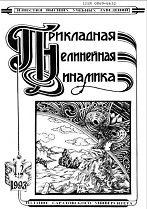|
MODELING OF GLOBAL PROCESSES. NONLINEAR DYNAMICS AND HUMANITIES
Modeling of oscillating population dynamics of aquatic organisms in the «resource-consumer» system using cellular automata
A. Yu. Perevaryukha
St. Petersburg Institute for Informatics and Automation of RAS
Abstract:
Theme. The article is devoted to modeling a specific biological nonlocal interaction of a species that is a resource and another species - its consumer, with the significant role of several time factors. Method. To represent the dynamics of sharp changes in the number of two populations in the model, we developed a new algorithm for changing the state of cellular automata using the Moore neighborhood. In the new model, the ternary state of the cells became available and the playing space was selected in a square lattice form. The novelty of the algorithm is the inclusion of heterogeneous forms of delay in the model for the propagation of red and green cells. The rules provide for several competing time parameters that act during the formation of the consumer population and take into account the delay in restoring spent resources. Result. We have obtained oscillating modes in the system of cells, where the recovery time of the species-resource is more important than the reproductive activity of the consumer. In the scenario of proliferation the initial group of red cells among the green ones, consumer and resource fluctuations are eventually synchronized. Practical significance. The model can describe the features of a spatially heterogeneous invasive process when, as a result, the invader is no longer able to form large clusters. Dynamics with slowly synchronizing oscillations was observed for the dangerous invader of the ctenophore Mnemiopsis leidyi and its rival, the jellyfish Aurelia aurita, after the ctenophore invasion in the Black Sea. The appearance in the new model of the front of propagation of invasion is confirmed by recent experiments with gene-modified virus in cell culture.
Keywords:
time parameters in models, critical scenarios of population dynamics, mechanisms of regulation of processes, cellular automaton, algorithm with delay, synchronized cycles, dangerous invasions.
Received: 19.06.2019
Citation:
A. Yu. Perevaryukha, “Modeling of oscillating population dynamics of aquatic organisms in the «resource-consumer» system using cellular automata”, Izvestiya VUZ. Applied Nonlinear Dynamics, 28:1 (2020), 62–76
Linking options:
https://www.mathnet.ru/eng/ivp356 https://www.mathnet.ru/eng/ivp/v28/i1/p62
|

| Statistics & downloads: |
| Abstract page: | 262 | | Full-text PDF : | 87 |
|




 Contact us:
Contact us: Terms of Use
Terms of Use
 Registration to the website
Registration to the website Logotypes
Logotypes








 Citation in format
Citation in format 